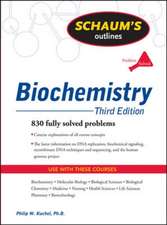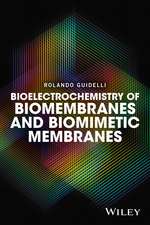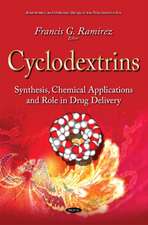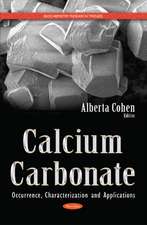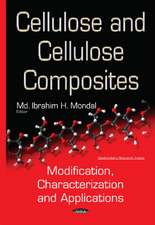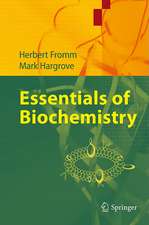Chemistry of Proteolysis
Autor Vladimir K. Antonoven Limba Engleză Paperback – 21 noi 2012
Preț: 400.47 lei
Nou
Puncte Express: 601
Preț estimativ în valută:
76.63€ • 80.22$ • 63.41£
76.63€ • 80.22$ • 63.41£
Carte tipărită la comandă
Livrare economică 05-19 aprilie
Preluare comenzi: 021 569.72.76
Specificații
ISBN-13: 9783662009819
ISBN-10: 3662009811
Pagini: 512
Ilustrații: XIII, 495 p. 112 illus.
Dimensiuni: 155 x 235 x 27 mm
Greutate: 0.71 kg
Ediția:Softcover reprint of the original 1st ed. 1993
Editura: Springer Berlin, Heidelberg
Colecția Springer
Locul publicării:Berlin, Heidelberg, Germany
ISBN-10: 3662009811
Pagini: 512
Ilustrații: XIII, 495 p. 112 illus.
Dimensiuni: 155 x 235 x 27 mm
Greutate: 0.71 kg
Ediția:Softcover reprint of the original 1st ed. 1993
Editura: Springer Berlin, Heidelberg
Colecția Springer
Locul publicării:Berlin, Heidelberg, Germany
Public țintă
ResearchCuprins
1 Substrates.- 1.1 General Characteristics.- 1.2 Amide Group.- 1.3 Unusual (Nonpeptide) Amide Bonds and Other Bonds of Carboxylic Acid Derivatives.- 1.4 Derivatives of Amino Acids and Peptides.- 1.5 Proteins as Substrates of Proteases.- 1.6 Water.- 1.7 Conclusion.- 2 Enzymes.- 2.1 Classification.- 2.2 Distribution.- 2.3 Characteristics of Certain Types of Amide Hydrolases.- 2.4 Primary Structure.- 2.5 Spatial Structure.- 2.6 Active Sites.- 2.7 Conformational Mobility of Enzymes.- 2.8 Proteolytic Activity of Enzymes Other than Amide Hydrolases. Catalytically Active Antibodies.- 2.9 Conclusion.- 3 Nonenzymatic Hydrolysis. Models.- 3.1 Thermodynamics.- 3.2 Kinetics.- 3.3 Mechanism.- 3.4 Catalysis.- 3.5 Conclusion.- 4 Enzyme Hydrolysis. Phenomenology.- 4.1 Enzyme Kinetics.- 4.2 Relationship of Rate and Equilibrium.- 4.3 Specificity.- 4.3.3 Stereospecificity.- 4.4 Efficiency.- 4.5 Comparison of Amide Hydrolase Efficiency and Specificity.- 4.6 Effect of Amide Hydrolases Modification on the Activity.- 4.7 Synthetic Activity of Amide Hydrolases.- 4.8 Unusual and Side Reactions Catalyzed by Amide Hydrolases.- 4.9 Conclusion.- 5 Regulation and Effect of External Factors.- 5.1 Zymogens and Their Activation.- 5.2 The Influence of pH.- 5.3 The Influence of Ions and Ionic Strength of the Solution.- 5.4 The Effect of Organic Solvents.- 5.5 The Kinetic Isotope Effect of the Solvent.- 5.6 The Effect of Temperature and Pressure.- 5.7 Cryoenzymology of Amide Hydrolases.- 5.8 Micellar Enzymology.- 5.9 Inhibitors.- 5.10 Activation.- 5.11 Allosteric Effectors.- 5.12 Autolysis.- 5.13 Conclusion.- 6 Enzyme-Substrate Complexes.- 6.1 The Forces of Interaction.- 6.2 Kinetics of the Complex Formation.- 6.3 Thermodynamics.- 6.4 Conformational Changes.- 6.5 Structure of the Complexes.- 6.6 Evaluation of the Overall Energy of the Enzyme-Substrate Interaction.- 6.7 Conclusion.- 7 Chemical Transformation of the Substrate.- 7.1 The State of Catalytically Active Groups.- 7.2 The Charge Relay System.- 7.3 The State of the Cleavable Substrate Group.- 7.4 Covalent or General Base Catalysis?.- 7.5 Electrophile.- 7.6 Nucleophilic Attack. Elementary Step.- 7.7 Tetrahedral Intermediate.- 7.8 Proton Transfer and Decomposition of Tetrahedral Intermediate.- 7.9 Acylenzymes and Enzyme-Product Complexes.- 7.10 Comparison of Enzymatic Hydrolysis Mechanisms.- 7.11 Some Aspects of Evolution of Chemical Mechanisms of Amide Hydrolases.- 7.12 Conclusion.- 8 Specificity and Efficiency. Concepts and Hypotheses.- 8.1 General Considerations.- 8.2 Factors of Catalysis.- 8.3 Theories and Hypotheses. Destabilization of the Ground State.- 8.4 Stabilization of the Transition State.- 8.5 Enzyme — “Machine”.- 8.6 Quantum-Chemical Description of Enzymatic Reactions.- 8.7 “Ideal” Enzyme.- 8.8 Ground State of the Elementary Step of Enzymatic and Model Reactions.- 8.9 Enzyme Does Not Decrease Activation Energy of the Elementary Step of the Chemical Reaction.- 8.10 Approaches to the General Theory of Proteolysis.- 8.11 Conclusion.- References.

